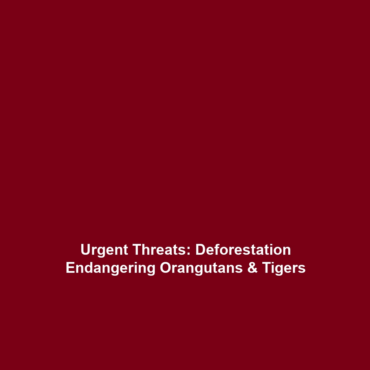The Threat to Critically Endangered Species Amid Deforestation and Biodiversity Loss
Introduction: The urgent crisis of deforestation and its impacts on biodiversity loss are particularly acute for critically endangered species such as orangutans, Sumatran tigers, and pygmy elephants. These species are not only invaluable to their ecosystems but are also indicators of broader environmental health. Their declining populations serve as a stark reminder of the repercussions of habitat destruction through logging, agriculture, and urban expansion. In this article, we explore the multifaceted threats these species face and the significance of preserving biodiversity as a whole.
Key Concepts: Understanding the Threats
The threat to critically endangered species like orangutans, Sumatran tigers, and pygmy elephants emerges primarily from habitat loss due to extensive deforestation. Below are major concepts related to this pressing issue:
- Deforestation: The conversion of forested areas into non-forest land for agriculture, urban development, and other activities.
- Biodiversity Loss: The decline in the variety and variability of life forms, which leads to ecological instability.
- Critical Endangerment: A classification assigned to species facing an extremely high risk of extinction in the wild.
Applications and Real-World Uses
Understanding the threat to critically endangered species has direct applications in conservation efforts and policy-making. Here are some significant applications:
- Habitat Restoration Initiatives: Counseling on how to effectively restore habitats crucial for the survival of threatened species.
- Eco-Tourism Development: Utilizing natural habitats responsibly to support the economy while conserving biodiversity.
- Conservation Policies: Influencing legislation that protects vast natural areas from deforestation.
Current Challenges: Barriers to Conservation
Despite efforts to protect critically endangered species, several challenges persist:
- Lack of Funding: Many conservation projects face budget constraints that limit their effectiveness.
- Political Instability: Regions critical for species survival may experience governance issues that complicate conservation efforts.
- Human-Wildlife Conflict: Increasing encounters between animals and human populations can jeopardize conservation initiatives.
Future Research and Innovations
The future of conserving critically endangered species looks promising with ongoing research and innovation:
- Genetic Research: Advances in genetics offer potential for breeding programs aimed at increasing population resilience.
- Remote Sensing Technologies: These tools help monitor deforestation and track animal movements to safeguard their habitats.
- Community Engagement Models: Strategies to involve local communities in conservation efforts are emerging as vital for long-term success.
Conclusion
The threats facing critically endangered species like orangutans, Sumatran tigers, and pygmy elephants are emblematic of the broader issues of deforestation and biodiversity loss. Understanding these threats is crucial for implementing effective strategies aimed at conservation. It is imperative for individuals, organizations, and governments to unite in efforts to protect these species and their habitats. For further reading, explore our articles on conservation strategies and the importance of biodiversity.
